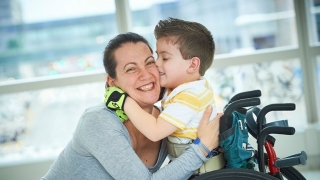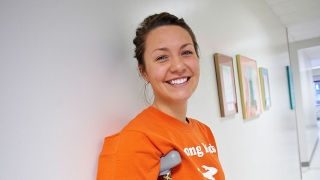Tarsal Coalition
What is tarsal coalition?
Tarsal coalition is an abnormal connection between two or more bones in the back of the foot. The condition can cause pain, stiffness and affect daily activities.
The bones most often involved in tarsal coalition are the calcaneus (heel bone), the talus, which connects the ankle to the foot, and navicular bones, which form the top of the foot at the base of the ankle. When two or more of these bones abnormally grow or fuse together — connected by bone, cartilage or fibrous tissue — a tarsal coalition is formed.
Tarsal coalition makes the back of the foot less flexible and interferes with the normal function of the foot. It can cause limping, muscle spasms and frequent ankle sprains. Tarsal coalition can affect one or both feet.
In most cases, tarsal coalition is present at birth but symptoms don’t typically appear until adolescence when the bones grow and harden. The overall incidence rate of tarsal coalition is unknown, but experts believe affects far less than 1 percent of the population.
Most children with tarsal coalition can be treated with nonsurgical options such as orthotics and physical therapy. If your child has severe symptoms, does not respond to nonsurgical treatments, and the condition interferes with their daily activities, doctors may recommend surgery.
Causes
In most cases, tarsal coalition is caused by a gene mutation that disrupts the normal prenatal development of bones in the foot. Less frequently, the condition has been linked to infections, injuries or arthritis.
While tarsal coalition begins before birth in most affected children, the condition is usually not discovered until late childhood or adolescence.
Signs and symptoms
Symptoms of tarsal coalition vary from child to child, and often worsen over time. In most cases, symptoms do not appear until your child’s bones begin to mature — usually between age 9 and 16.
Symptoms of tarsal coalition can include:
- Pain and stiffness in the foot and ankle, particularly when your child is walking or standing
- A rigid flat foot, which may make walking more difficult
- Walking with a limp
- Muscle spasms in the leg, which can cause the foot to turn inward
- Frequent sprained ankles
Some children with tarsal coalition will experience no symptoms during childhood, but may develop symptoms or pain later in life.
Testing and diagnosis
Your child’s pediatrician may be the first to suspect your child has tarsal coalition. Evaluation by a trained pediatric orthopaedic physician is recommended because the condition can mimic the symptoms of other foot disorders and can be difficult to identify.
At Children's Hospital of Philadelphia (CHOP), a pediatric orthopaedic physician will perform a complete medical history, a physical examination of your child’s foot and ankle, and an overall visual evaluation of your child. Clinicians will examine your child’s foot for flexibility and assess whether your child has a flat arch that does not correct when your child stands on their toes.
Your child will be asked to describe any pain, stiffness or other symptoms they are experiencing, as well as what activities ease the pain or worsen it. Doctors will also observe your child standing, walking and running (if possible) to get a better understanding of the mechanics of your child’s foot.
To accurately determine the presence and severity of the tarsal coalition, as well as which bones are involved, doctors will also order imaging tests such as:
- X-rays, which produce images of bones.
- Computed tomography (CT) scan, which uses a combination of X-rays and computer technology to examine bones and produces cross-sectional images ("slices") of the body.
- Magnetic resonance imaging (MRI), which uses a combination of large magnets, radiofrequencies and a computer to produce detailed images of organs, soft tissues, muscles, ligaments and other structures within the body. Your child is exposed to no radiation during an MRI.
Treatment
If your child’s tarsal coalition is not causing pain or discomfort, no further treatment is usually necessary. Yearly checkups with your child’s pediatrician are encouraged to address any issues that may develop as your child grows.
Nonsurgical treatment
If your child’s tarsal coalition is affecting their daily activities, doctors may recommend one or more of these nonsurgical treatments:
- Orthotic devices — Arch supports, shoe inserts and other orthotic devices can help distribute your child’s weight, stabilize their foot, limit motion at the joint, and relieve pain.
- Physical therapy — Stretching exercises, range-of-motion exercises, massage and other therapy can improve your child’s flexibility and stability.
- Rest — Your child may be encouraged to take a break from high-impact activities (like running and jumping) for three to six months to allow their bodies time to recuperate.
- Temporary cast or boot — Sometimes the best way to get a child to rest their affected foot is to place it in a temporary cast or boot. Crutches can help your child get around while taking stress off the bones in the foot.
- Medications — Over-the-counter, anti-inflammatory drugs (such as ibuprofen) can reduce pain and swelling.
- Injections — Some children may benefit from cortisone (steroid) shots into the affected joint to reduce pain and inflammation, or anesthetic injections to relax leg spasms.
Surgery
If nonsurgical treatments do not relieve your child’s pain or improve their foot function, surgery may be considered. Depending on your child’s age, condition and activity level, surgeons may recommend resection or fusion surgery.
In resection surgery, the tarsal coalition is removed from your child’s foot and then replaced with muscle or tissue from another part of the body. The goal of resection surgery is to relieve symptoms, and improve or preserve normal foot motion.
For more severe cases of tarsal coalition that include significant deformity or arthritis, fusion surgery may be appropriate. During surgery, surgeons realign bones in the foot and ankle into the correct position, then secure them with screws, pins and plates. After surgery, foot movement will be limited but pain should significantly decrease.
Safety in surgery
Surgery can dramatically improve the long-term outcomes for your child with tarsal coalition, but it can also be a stressful experience for you and your child.
At CHOP, we offer a wealth of resources that can help you and your child prepare for surgery. Additionally, we follow many best practices before, during and after surgery to decrease the risk of infection and increase positive outcomes. Our safety protocols have been so successful that they have been adopted by many other institutions. To learn more, read how we make safety in surgery a top priority.
Post-op care
After surgery, a cast will be applied to your child’s foot and ankle to protect the surgical site, immobilize the joint and discourage your child from putting weight on the affected foot. After several weeks, the cast will be removed and may be replaced with a walking boot.
Your child’s doctor may recommend physical therapy or orthotic devices, such as arch supports, to help your child restore their strength and range of motion after surgery and recovery.
Follow-up care
At Children's Hospital of Philadelphia (CHOP), we offer a wealth of ongoing support and services for your child and family at our Main Campus and throughout our CHOP Care Network. Our team is committed to partnering with you to provide the most current, comprehensive and specialized care possible for your child.
We recognize your child's pediatrician as an important part of the clinical team and provide regular updates on your child's progress. If continued care and monitoring is necessary long-term, we will help transition your child's care to an adult orthopaedic team.
Outlook
Most children with tarsal coalition will never know they even have the condition. For children who do experience pain or stiffness, nonsurgical treatments are helpful in most cases. Children with a serious foot deformity related to tarsal coalition will likely require surgery, but most will recover fully within months and have improved motion and pain relief.
Reviewed by Alexandre Arkader, MD



